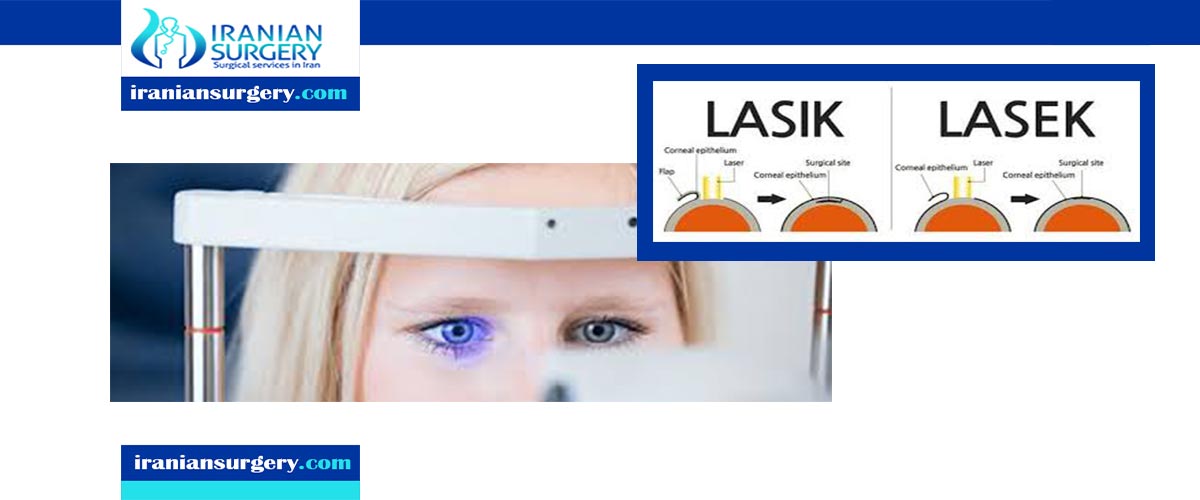Lasek eye surgery in Iran
What is Lasek?
LASEK is an eye surgery that combines many of the benefits of other vision correction surgeries in Iran.
LASEK eye surgery is a variation of PRK to correct myopia (nearsightedness), hyperopia (farsightedness) and astigmatism. LASEK combines certain methods from both LASIK and PRK.
LASEK stands for Laser Assisted Sub-Epithelial Keratectomy. It’s a better choice if you have a thin cornea or a medical condition that makes laser eye surgery more challenging to complete. During the surgery only one laser will be used to correct your vision— rather than the two that are used in LASIK.
An alcohol solution is put on to the surface of your eye and an ultra-thin sheet applied. This alcohol solution loosens the thin layer of cells on your eye’s surface called the epithelium. These cells then stick to the sheet, which is then gently moved to the side of your eye, giving your surgeon access to the layer of your cornea which will be treated by the laser.
After the laser has reshaped your cornea, a special protective contact lens will be put on your eye to increase your comfort whilst it heals. This lens is normally taken off after about four days. Like LASIK, both eyes can be treated on the same day. A lot of patients can see an immediate improvement in their vision, but it may take a number of days for your vision to settle. The recovery process can take slightly longer— usually a couple of weeks. The slightly longer recovery time of LASEK is a small compromise to make when it comes to correcting your vision for the long term with laser eye surgery— something that you wouldn’t be able to benefit from otherwise.
How to prepare for LASIK surgery?
Usually, the doctor makes a final opinion on or prohibits LASIK by examining the eye and measuring corneal thickness, ocular pressure, pupil dilation and refraction, as well as examining the patient's medical history.
If the patient is appropriate for surgery, it is advisable not to use permeable gas contact lenses three weeks before, and conventional contact lenses are usually thankful for up to three days before surgery.
The preoperative meal should be light and any eye makeup on the day of surgery is forbidden.
prons
Both LASEK and LASIK are generally safe and effective, but Lasek patients report slightly better long-term results. Although the initial recovery is longer than LASIK, LASEK patients report less postoperative discomfort. There is also a decreased risk of infection and decreased incidence of corneal haze after LASEK.
With a LASEK procedure, there is no concern over the possibility of cutting irregular flaps as in LASIK. Some people undergoing Lasek have a faster recovery of nerve sensation in the cornea. Because the corneal nerves play some role in the feedback mechanism that keeps your eyes lubricated, there appears to be less incidence of dry eye, a common complaint after having LASIK surgery.
cons
The main disadvantage of LASEK is a slower healing time. Although usually mild, some people seem to experience a bit more pain than those who have undergone LASIK. Most surgeons will also require you to wear a bandage contact lens for the first 4 to 5 days after a LASEK procedure.
LASEK Risks and Complications
- Blurry vision, halos and glare.
- Significant overcorrection, undercorrection or regression which may require further surgery or reliance on eyeglasses or contact lenses for some or all activities.
- Dry eyes.
- Eye infection and irritation.
The differences between lasik and lasek
Laser surgeries are used in close-ups, the camera, and astigmatism. Recent research shows that LASIK and LASIK are equally useful. In both surgeries, the laser is used to remove layers and form the cornea In LAZ (photorefractive keratectomy) this peeling is performed only in the outer cornea, So some of the problems that are happening in LASIK, This type of surgery is less common, but the recovery period is longer and there is more pain after surgery. Some doctors believe Laz is better, some believe LASIK, That's why researchers at the University of Illinois at Chicago did research and found that both surgeries were safe, effective, and predictable,
Although the eyes treated with lasik had a better vision, the change was so minor that patients were unable to detect.
10 common question about lasek eye surgery
[kkstarratings]



